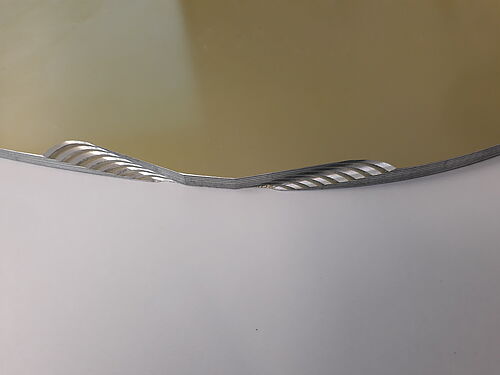

The increase of light weight construction in the mobility comes together with a high demand for lightweight construction materials. Besides pure CFRP, fibre-reinforced plastics combined with thin metal layers of less than 500µm of height, so called Fibre-Metal-Laminates (FML), gain importance as an alternative to pure Aluminium or pure CFRP. Glass-Fibre-Metal-Laminates marketed using the product name GLARE (Glass Reinforced Aluminium Laminate) as shown in the picture on the left side are currently used e. g. in AIRBUS A380 as segments in the upper fuselage area. New combinations of fibre-reinforced plastics with thin metal layers, e. g. CFRP-Titanium and CFRP-stainless steel are topic of research, especially with significantly lower metal contents.
In FML, impact damages with low energy input can already cause subsurface, from the outside barely visible damages. The figure below illustrates the influence of the ductility increase with the increase of metal content: while a large content of fibre-reinforced plastic promotes brittle matrix fractures, buckling and cracks dominate the appearance of the damage with increase of the metal content in the laminate.

Due to the risk that damages in laminates might not be visible from the outside an integrated component monitoring is of great importance also for FML. The aim of a component monitoring system is to answer the following questions:
Especially the detection of the damage type and statements about the extent of the damage in components made from layered materials with anisotropic layers and high impedance differences between the layers require still considerable profond research.
The use of metallic materials in laminates leads to inner interfaces due to huge acoustic impedance differences within the buildup, which have – according to our hypothesis – an impact on the propagation of Guided Ultrasonic Waves (GUW) and consequently on an ultrasound diagnostic procedure. Recent research activities point at integrated systems for component monitoring, so called Structural Health Monitoring (SHM), which are capable of recognizing structural damage using Guided Ultrasonic Waves without external inspection. These integrated systems allow the operators of the lightweight constructions not only a guarantee of high security, but also to fullfill growing demands on cost-effectiveness by load-adapted maintenace intervals. In the last decade, numerous scientific advancements for pure CRFP constructions in the area of SHM could be achieved, first systems are investigated and tested for the use in aircraft construction. SHM systems have not yet been sufficiently studied for use in FML.
The focus on FML raises a number of fundamental structural-mechanical questions, which are based on the special features of this material class and the types of damage to be detected:
The aim of the proposed Research Unit FOR3022 is to gain a profound understanding of an integrated Structural Health Monitoring (SHM) in Fibre Metal Laminates (FML) using Guided Ultrasonic Waves. This requires an integral view on the physical phenomena of wave propagation even under complex environmental conditions, their interaction with hidden damage, recording of these interactions using micro-technical sensors at the location of event, and a signal processing for full damage diagnostics. The findings will be useful for the consideration and comprehensive understanding of wave propagation in all layered material systems made from components of large impedance differences.